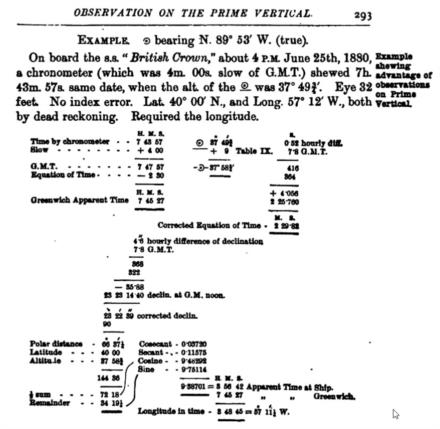
NavList:
A Community Devoted to the Preservation and Practice of Celestial Navigation and Other Methods of Traditional Wayfinding
From: Ed Popko
Date: 2018 May 17, 11:11 -0700
This topic has probably been covered in previous posts but I could not find it in searches, so I'll ask it again.
In one of the random three-pick posts today (bottom of the home NavList page), a post by Gary LaPook (July 17, 2011 When did "time sights" fade away?) appeared with time sight examples from Lecky's "Wrinkles in Practical Navigation" 1884. (Gary's post https://NavList.net/imgx/Longitude-pages-from-_Wrinkl.pdf)
Lecky's example on page 293, image attached, illustrates my frustration with reconsiling time units in the last step of determining longitude by 19th century methods. Yes, this is a text book case and not a 'scrap' to be decoded, but it illustrates perfectly one of the problems I have with chronometers in finding longitude once I have found local time.
We have a slight advantage with this example because the intro text tells us this is an afternoon time sight and DR so we have a lot of starter information to begin with. You don't always know all this with 'scraps'. In this example, the body is west of the observer so we know if the time is added to or subtraced from 12 to when going from LHA time to apparent time. Let's ignore Equation of Time for the moment since it doesn't figure into my question.
Look towards the bottom in the final steps. The example shows Apparent Time at the Ship to be 3:56:42 and Greenwich time 7:45:27. Given the date above, 1880, we know we are dealing with GMT Civil Time or 12:00:00 at noon.
Notice in the calculations at the end, both LMT and GMT are short 12 hrs, that is, LMT is not 15:56:52 and Greenwich 19:45:29. The resulting difference between them is still the same so the longitude calculation is OK, but it's curious that 12 was not added to both. Is this a shortcut? Is the chronometer aboard 12 hrs off, kept in Nautical Time? Why is this?
Any thoughts why the final times, local and Greenwich, were done this way? This is not the only example and the one big stumbling block for me when I decode these old sights.
Ed Popko







